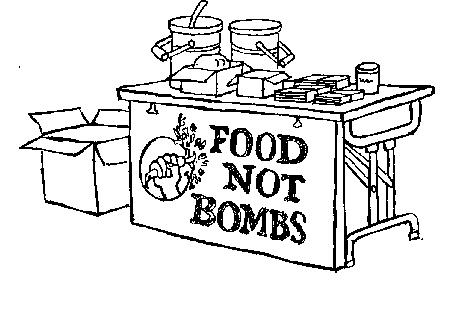
| Contents | Start | Previous | Next |
Each cooking team usually operates with whatever management style is comfortable to them. Sometimes one person becomes "the head cook" for the whole team and at other times, each person takes one dish and prepares it from start to finish. The team may also choose to do everything cooperatively. The recipes you use can be ones you already know or they can be from the recipe chapter of this book. Once the meal is prepared, the cooking team cleans the kitchen, packages the food for transportation, and loads it into the Food Not Bombs vehicle for delivery to the serving site.
Sometimes the serving and the cooking teams are the same people; usually, they are different. The serving team arrives at the site and organizes the food distribution and the staffing of the literature table. Always try to have a hand-washing bucket with soap and a rinse bucket with just a little bleach, so the volunteers can wash their hands before serving. Try to keep the food away from the literature. If a long line develops, have someone go up and down the line handing our bread or muffins or maybe something to drink on hot days, so the wait is not too unbearable. This also helps reduce the tension created by fear that the food might run out. Ifyou can find musicians or other street performers to come and perform while you're serving, this will also reduce tensions and create a very positive, festive atmosphere. The serving team is also responsible for cleaning up both the site and the equipment and for returning the equipment to wherever it is stored.
The collection of cash donations at the food table is an ongoing debate. Sometimes it is completely out of place to ask for donations, but in other situations, people insist on being allowed to contribute to the collective work. In any event, always encourage the idea that everyone can have as much food as they want without regard to their ability to pay. Food is a right, not a privilege.

At every outdoor event, the first decision the group needs to make is where to place the tables, and there are many important issues to consider. If possible, look at the location ahead of time. At demonstrations, having the food table as close as possible to the focal point of the demonstration has been very successful. Being close to the action encourages people to stay involved and not drift away. Sometimes the most desirable location is the one with the most foot traffic. Other times, it is the most visible, accessible location for people without homes. It is always a good idea, however, to be sensitive to nearby restaurants and vendors with similar types of food; they might complain and have your operation shut down if they feel it is in competition with theirs.
The following diagrams offer two possible layouts of your field kitchen.
One is more basic, involving a minimum of equipment. The other involves
more equipment and would be able to pass a health department inspection
in most cities. In general, Food Not Bombs believes that our work does
not require any permits. However, the city or the police often use the
permit issue as a way to attempt to harass you and shut you down. Therefore,
it is sometimes a good idea to have a fully equipped field kitchen. There
may still be attempts to shut youdown, but you can point out that it
is
not a health but a political issue they are raising. It is the Food Not
Bombs position that we have a right to give away free food anytime, anywhere,
without any permission from the state.
| Contents | Start | Previous | Next |